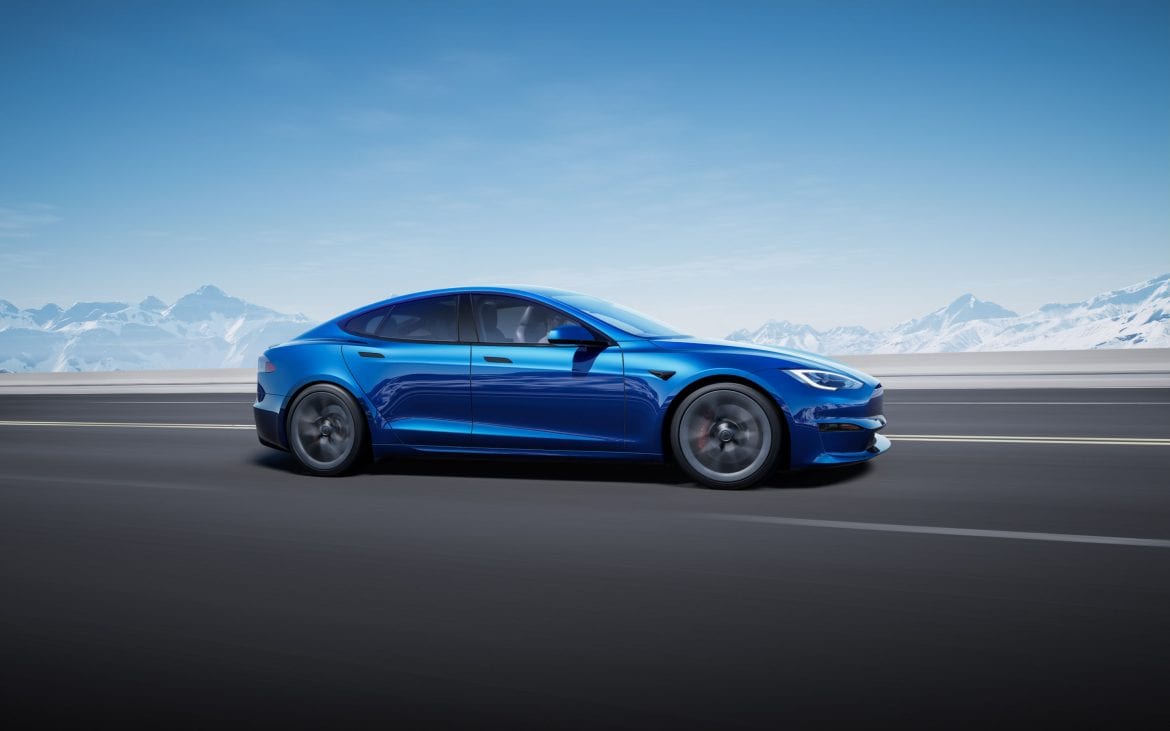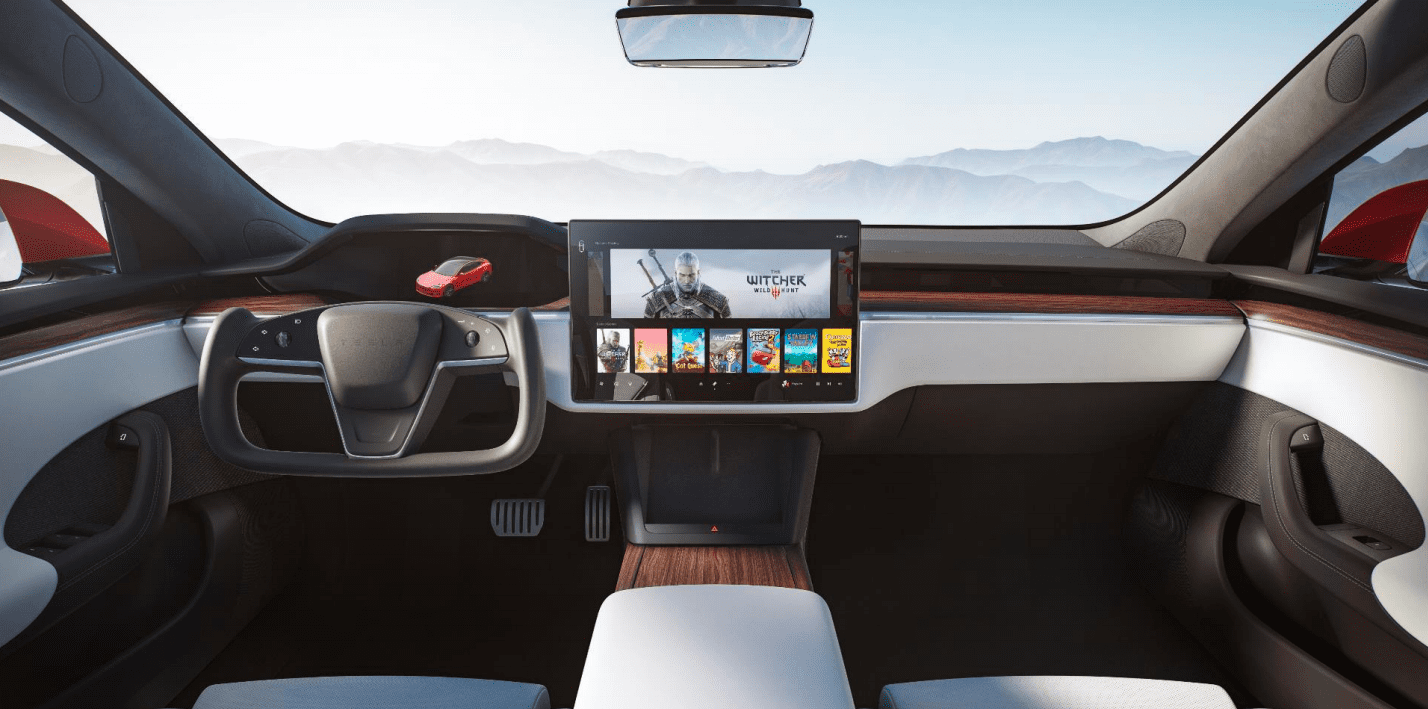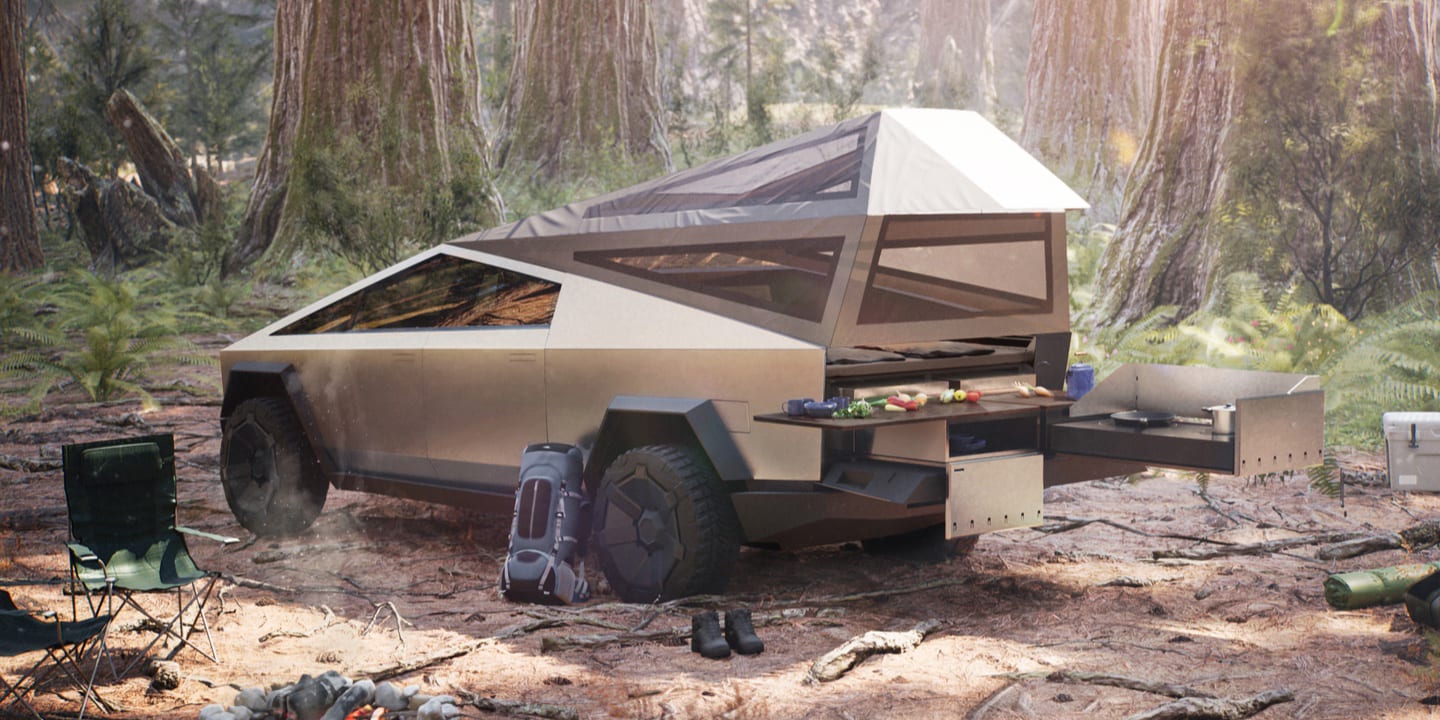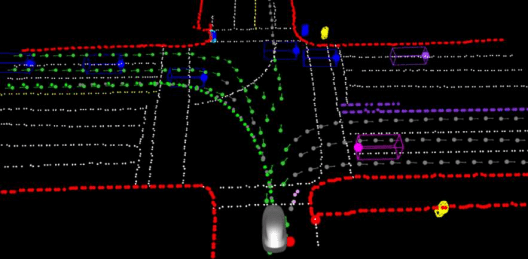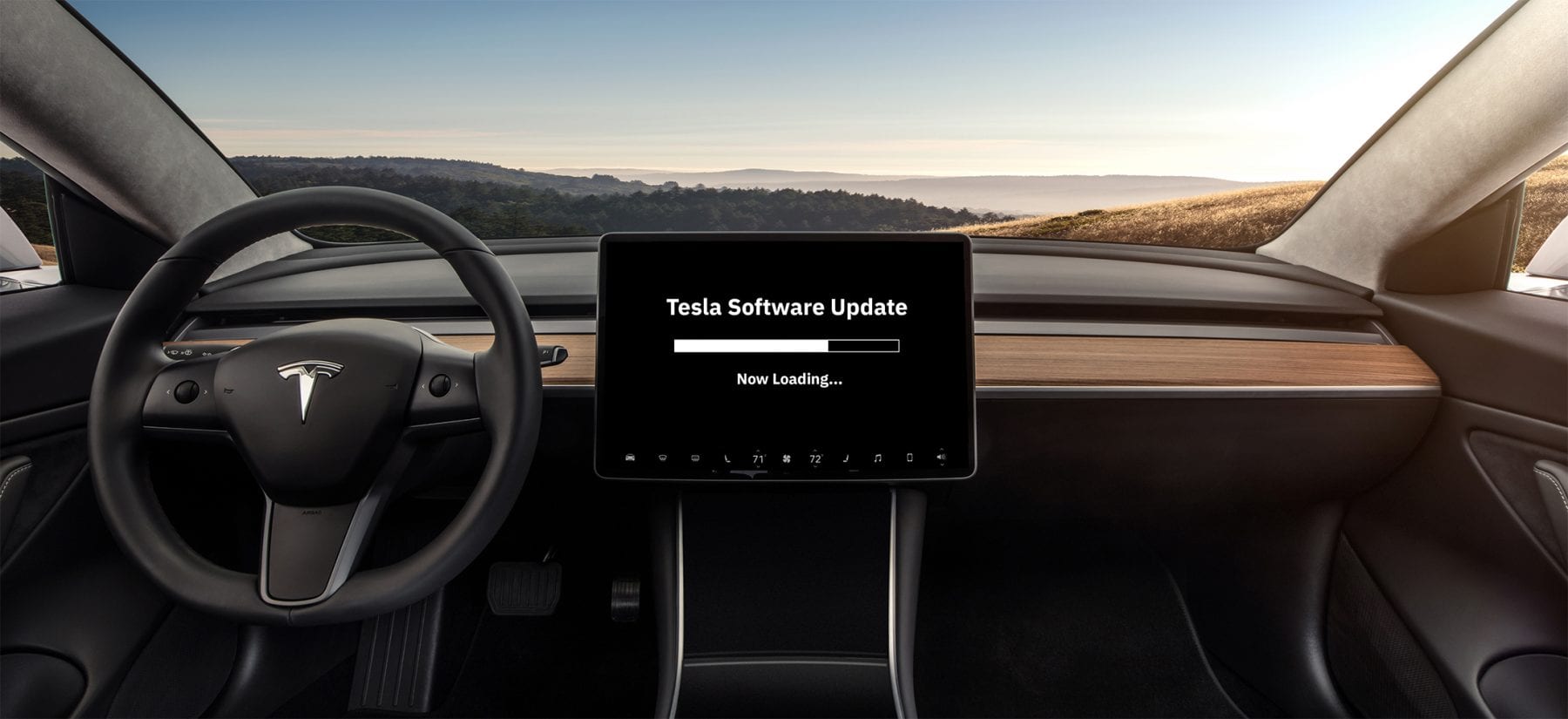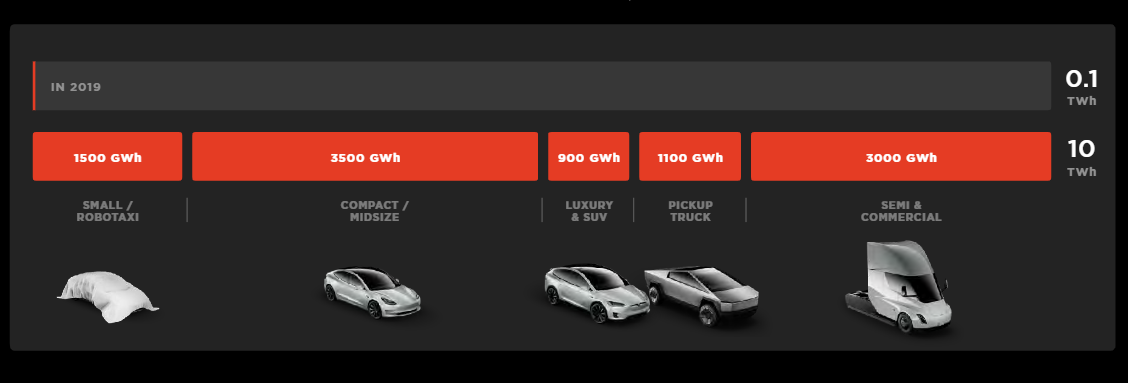What’s Tesla got cooking in 2021? A lot. New cars, new factories, new batteries, new FSD advancements, it’s all there. While every year seems to be a stacked and chaotic mess for the electric car brand, this one might be the most packed year since Tesla’s inception. Here’s what we have to look forward to from Tesla in 2021.
Model S/X Refresh
Leading the way for Tesla’s 2021 calendar of events are the newly refreshed Model S and Model X that were shown during Tesla’s Q4 2020 earnings report. The Model S/X refresh has been a long time coming for many Tesla fans that have grown tired of the lack of design changes in the companies two oldest vehicles.
While the outside of each car didn’t receive an extensive rework, the interior sure did. The big new additions are the horizontal center screen, rear passenger screen, yoke steering wheel, and other smaller changes such as the absence of any stalks behind the wheel. A big push in this Tesla refresh is the new center screen which Tesla has stated as being as powerful as current-generation gaming consoles. The promotional material shows the Witcher 3 video game as an option with Musk also stating that the system should be able to play Cyberpunk 2077. Even if the Model S/X doesn’t pan out well for gaming, the interior redesign is a good breath of fresh air for many.
The sales of the Model S/X have seen a steady decline since the start of the Model 3 and Model Y. While the difference in price is probably the main contributing factor, the stagnant design could also be a major reason for the lackluster performance. Although the refresh should attract more eyes to the S/X, both of them also received a $10,000 increase in their prices, erasing some of the hype for the new look. Nonetheless, Tesla’s earnings report showed that the Model S/X production capacity at Freemont will increase from 90,000 to 100,000 cars so Tesla seemingly anticipates that demand for both the electric cars will increase throughout 2021.
Model S Plaid+
It has been about a year and a half since Porsche and Tesla went head to head at the Nurburgring trying to one-up the other. It was during that time where many spied a modified Model S that looked a tad bit more aggressive. We came to find out that Tesla was testing out a tri-motor setup for their Model S derived from their experience with the development of the new Roadster. During last year’s Battery Day presentation the Tesla Model S Plaid was unveiled with the following specs:
- 0-60mph: <2 sec.
- Top Speed: 200mph+
- Range: >520 miles
Needless to say, those are absolutely bonkers performance metrics. With the reveal of the Tesla Model S/X refresh came an update to the Plaid variant. The tri-motor Tesla Model S would be available in two variants, the Plaid and Plaid+.
The difference between the two mainly lies in range as the Plaid has 390 miles of range while the Plaid+ has 520+. The difference in speed will only be noticeable to people going to the drag strip as the Plaid has a 1.99 sec. 0-60 and 9.23 sec 1/4 mile while the Plaid+ is <1.99 seconds and <9.0 seconds respectively. Still, the Model S Plaid+ will represent a feat for Tesla as it would be the quickest production car built, highest range of an EV, and still able to carry four people. You'll now take comfort in the fact that you'll basically be able to smoke any car on the road during your mid-week grocery runs. The Plaid Model S is scheduled to begin deliveries later this year, shortly after the refresh Model S/X hit the roads.
Cybertruck Unveil
Do I even need to write anything here? I’m sure at this point that you have read over a hundred articles about the Tesla Cybertruck. You either think it’s the ugliest thing imaginable or it exceeded your wildest dreams.
With its reveal in late 2019, the Cybertruck not only represented a large departure from Tesla’s typical passenger vehicle offerings but also from their stylings. The reveal also gave us a hoard of memes thanks to Tesla’s indestructible glass being broken, twice. While first impressions were certainly mixed, current crowdsourced projections have the (refundable) reservations at over 750,000 customers, so clearly there is some love for the electric truck.
The reveal however was just a concept. While we don’t expect the production version to stray away too much from the unique design, a few changes do have to be made. For one, it needs mirrors to legally roam our streets.
The Tesla Cybertruck looks to bring some good utility with its large size, but that large size might be too big for many places outside of the United States. Following the reveal of the Cybertruck, Musk took to Twitter to say that the team had been mulling over the thought of slightly scaling down the size of the Cybertruck. Whether or not the Cybertruck would actually receive this roughly 3% size decrease was unclear throughout 2020. However, earlier this year, in an interview with Joe Rogan, Musk stated that the design process had been completed and that the team ended up scaling down the truck by about 3%.
Cybertruck Production
Tesla is keen on maintaining the momentum following the 2020 release of the Model Y. While the Model Y was able to beat its expected delivery date by quite a large margin, the Cybertruck is not expected to begin significant deliveries until late 2021, possibly early 2022. Not only is its construction much different from all of Tesla’s other vehicles, but the truck still has to wait for its own Gigafactory in Texas to be completed for production to begin. So while production of the Cybertruck is set to begin in 2021, it won’t really make an impact until 2022.
Since the unveiling of the Cybertruck, the list of upcoming electric trucks has slowly been growing. While Tesla will be one of the first to market, with only Rivian set to be ahead, its competition is fielding some very good electric trucks of their own. The choice towards a Cybertruck won’t be as clear of a choice as the Model 3 or Model Y was upon their releases.
Smaller Cybertruck
Musk answered a question on Twitter regarding the possibility of having a smaller version of the Cybertruck come to the EU. In typical Musk fashion, the reply was “Highly likely down the road”. Since then there has not been any news regarding a smaller Cybertruck. Understandably so, as Tesla is still busy trying to get the regular version ready. A big question regarding the smaller Tesla truck is if it will carry the same radical stylings or if Tesla will take the opportunity to create a more conventional-looking truck to hopefully capture some of the market that was turned off by the cyberpunk design.
Just like the Tesla van down below, a smaller Cybertruck is probably a few years away so we doubt any big information will be given out in 2021. But do lookout for a couple of tweets here and there from the CEO over the course of the year to see if the project is still underway.
Tesla Semi Production
First revealed in 2017, the Tesla Semi has been a long time coming. It is the oldest revealed Tesla that has not yet been fully released (just barely, as the Roadster was revealed at the same event). Every year we look forward to Tesla finally making it happen, and we are always met with delays. That is not to say that the Semi has not existed, far from it. Over the past few years, we have seen Tesla Semis rather regularly as Tesla made some in low volumes to both test them and to be used for hauling their own cars.
So it seems like Semi production has been possible for a while now and that’s why many are left confused as to why it hasn’t been delivered to the multitude of companies that have placed down orders. One of the main reasons given is the number of battery cells that would have to be dedicated to the Semi. Musk on multiple occasions has stated that the battery used to make on Semi could be used to make multiple Model 3s. As long as there was a high demand for their regular cars and supply-constrained batteries, it made financial sense to further delay the Tesla Semi.
With all the being said, it looks like 2021 will finally be the year that the Semi goes into production, we swear this time. Leaked emails towards the end of 2020 saw Musk wanting the Semi to be ready for low-volume production, but those plans fell through. While Tesla’s 2021 outlook was rather vague, one thing was for sure and that was that the Semi would go into production in 2021.
We are currently building Model Y capacity at Gigafactory Berlin and Gigafactory Texas and remain on track to start deliveries from each location in 2021. Gigafactory Shanghai will continue to expand further through the course of the year. Tesla Semi deliveries will also begin in 2021.
Going to Tesla’s career page and searching for ‘Semi’ will return a few positions that Tesla is looking to fill for their Semi project, so the gears are spinning. Fingers crossed.
As a refresher the Semi will be available in two configurations with ranges of 300-miles and 500-miles, costing $150,000 and $180,000 respectively. Given how much Tesla has boosted the ranges of their cars since 2017, it wouldn’t be too surprising if the production versions actually had elevated ranges.
New Tesla Factories
Tesla factories are as much of a product for Tesla as the cars and batteries are. 2021 will be a very busy year for Tesla as they continue to expand their production capabilities in not only cars but battery cells as well.
Giga Berlin Starts Production
Tesla’s Berlin Gigafactory will represent an important step in helping address demand for Teslas in the European market. With construction starting in early 2020 the factory is expected to start production around mid to late 2021. Unlike the Shanghai Gigfactory, the first model coming off the production line will be the Model Y rather than the Model 3, which by some estimates might not start European production until early 2022.
Giga Berlin is not only important for the company because it gives them a better foothold in Europe, but it will also debut some of Tesla’s newest production technologies. As such, the European-built Model Y will be considerably different from the Model Y being built at Freemont and China. It will incorporate Tesla’s newest 4680 battery cells as well as their new structural battery pack. According to Musk, it will take around two years for these technologies to make their way to both the Freemont and Shanghai factories once they have been proven.
Berlin will use 4680 cell with structural battery pack & front & rear single piece castings. Also, a new paint system. Lot of new technology will happen in Berlin, which means significant production risk. Fremont & Shanghai will transition in ~2 years when new tech is proven.
For the time being it looks like construction of the factory is proceeding smoothly, so barring any sort of massive failures, we should see Gigafactory 4 become operational.
Giga Texas Starts Production
The newest of Tesla’s upcoming factories (thus far) will look to hopefully become operational this year. The need for yet another factory was highlighted following the large reservation numbers for the unveiled Tesla Cybertruck. With some counts having the total reservations over 700,000, it was clear that yet another factory would have to be built.
After bids from multiple mid-western states, it appeared to have come down to either Tulsa, Oklahoma and Austin, Texas as the finalists. Tulsa offered both a statue of Elon Musk as well as a Big F—ing Field, but it still lost out to Austin when decision time came in mid-2020. Musk did however make a comment that he would like to eventually have something built in Tulsa. The new Texas Gigafactory will not only be responsible for building the Cybertruck but will also produce the Model Y and possibly the Tesla Semi.
With deliveries of the Cybertruck still set for late 2021, the new factory would have to be at least partly operational by at least the third quarter of 2021. An old post on TMC shares purported documents that Tesla sent out to contractors in which they list the “First Substantial Completion” as May 1st, 2021. Substantial Completion is defined as the point at which the owner of the building could start using it for its intended purpose. Given Tesla’s track records when it comes to fast-tracking their production efforts, a May 1st date isn’t the most unrealistic date.
As of the writing of this article, the factory looks to be coming along nicely. For those that want to stay up to date on the progress of the factory on the daily, follow Jeff Roberts on Twitter, as he posts daily drone footage of the construction site.
4680 Cell Pilot Factory
One of the big points during Tesla’s Battery Day was their need for more batteries. Tesla has been in a perpetual state of being battery limited and it’s one of the contributing reasons for the absence of projects like the Tesla Semi which are very battery hungry. To help with the need for more plentiful and cheaper batteries Tesla revealed its new 4680 battery cell as well as a pilot factory down the street from the Freemont factory.
Not much Tesla factory news has been given about the factory aside from its capacity should be about 10 GWh within the year, which actually is a decent amount of batteries for a regular factory let alone a test factory. With Tesla planning to have 100 GWh of battery production in 2022, it will be imperative for their pilot factory to succeed and either be further expanded or easily have more of them built in other locations.
Autonomy
Elon Musk continues to be confident that Tesla’s FSD system will be able to achieve Level 5 autonomy by the end of the year. Whether or not the average consumer will be able to experience any of it by that time is a whole other story. Still, there will be a large increase of people who will get a chance to experience the current builds of the FSD beta.
While the FSD beta was released at the end of 2020, it was only available to a handful of people, but this will soon change. In early March Musk took to Twitter to say that Tesla will be giving everyone with the FSD package an option to download the FSD beta at their own discretion. Availability of the download will depend on the region, but the point of the matter is that FSD is about to be tested on a much larger scale. It’s certainly risky opening it up to so many people following only having it available to a few hundred people, so Tesla must be very certain that their system is safe enough.
Tesla AI Day
Over the past few years, Tesla has started a tradition of having a yearly event in which they highlight some of their technologies, it’s one of the ways the company is able to keep itself in the public consciousness constantly. Two years ago we had Autonomy Day, last year we had Battery Day, and this year Musk said that we’ll “maybe [have] a Tesla AI day later this year”.
As with a lot of these Tesla 2021 things, information on what that will actually entail is limited, but that’s always the fun part. We imagine that AI Day will deal with autonomous driving just like Autonomy Day did a few years ago. However, while Autonomy Day’s main focus was on the new Hardware 3.0 that Tesla was debuting, AI Day should primarily focus on software and the neural net. Over the past few years, Tesla has talked about its ‘Dojo’ neural net training computer that processes all the data from Teslas around the world to better improve the Autopilot and FSD experience.
A concrete date hasn’t been given, but it could take place around the same time that Battery Day did in 2020, around late September or early October. With the event still be a little bit away, it will give Tesla enough time to continue perfecting their autonomy and hopefully show something amazing at the event.
Autopilot 4D
In Elon Musk’s own words, the current Autopilot arrangement only uses 2.5 dimensions, and that’s just not good enough. That’s why Tesla is hard at work to bring an update to Autopilot that would see it using “4D”. The specifics of what exactly 4D means in its entirety, but we do know that it will use simultaneous surround video from all 8 cameras. This will supposedly allow for more precision when it comes to Autopilot recognizing objects around it. Additionally, Musk stated that the labeling software that they used to label cars, streets, buildings, etc. has also been rewritten for the 4D update.
Timelines are unclear, it’s probably safe to assume that it won’t be around until the second half of the year and maybe close to Tesla’s AI Day.
HW4.0
A few years ago we had Autonomy Day, in which Tesla showed off their new chip Hardware 3.0. The new hardware was 21 times more powerful than the outgoing Hardware 2.0 with almost no increase in power consumption. This news was quickly supplanted by the announcement that Hardware 4.0 was being developed and would be three times more powerful than the 3.0. HW3.0 however is supposed to be able to handle FSD when it’s ready.
That was a while ago now, and we are closing on the supposed date for when Tesla should unveil the new hardware. A report from China Times in late 2020 stated that Tesla is working with chip manufacturer TSMC to create their chip, giving us some indication that progress is being made.
According to industry news, Broadcom and Tesla are cooperating to develop ultra-large automotive HPC chips, which are produced using TSMC’s 7nm process, and for the first time using TSMC’s SoW advanced packaging technology. Each 12-inch wafer can only be cut out. 25 chips. Production of the new chips will begin in the fourth quarter, with an initial production of about 2,000 wafers. It is expected to enter the full mass production stage after the fourth quarter of next year.
Based on the report it looks like a small batch of engineering samples will be made at the end of this year with full production starting shortly afterward or in early 2022. Nonetheless, we should see something regarding the new hardware this year. With HW3.0 supposedly being enough to run FSD, the extra power from the new chip shouldn’t matter too much. FSD should either work or not work, there shouldn’t be a case where HW4.0 equipped cars have a better running FSD.
So what’s the point of moving on to another chip if the current one should be enough? Well, there’s always the case that HW3.0 isn’t enough, and who knows what Tesla does to appease all its angry owners in that case. If we don’t assume the worse, then moving down to the 7nm process would still provide benefits in that the chip should be able to use less power and give off less heat while being more powerful than the current chip. It might seem silly to try and save a comparably small amount of energy compared to the motors, but every Watt counts.
It is important to note that as of the writing of this article, the world is facing a computer chip shortage. It is unclear if the current supply shortage will have an effect on HW4.0 production toward the end of the year, but a delay might be possible.
V11 Software
The holiday Tesla software update was believed to be our first look at Tesla’s big V11 software update. While Musk said that the update would be TWO fire emojis, some people were expecting more, especially if you didn’t have a pedestrian speaker to take advantage of the new custom sounds. Musk took to Twitter to say that the update might have only been ONE fire emoji to some and that the team was not able to implement everything on time.
Looking at the refreshed Model S/X, we clearly see a different interface than what we have now, so is that the other part of the new software update that wasn’t able to be done in time? Is it a working concept or just something done for illustration? We won’t have to wait too long as the first refreshed models are making their way into owners’ hands who will most certainly let us know if anything has been changed.
Tesla App Store
We wondered about it last year and we will continue to wonder about it in 2021. While last year it seemed like quite a stretch to imagine a Tesla app store, it seems like less of a stretch following the refresh we saw for the Model S/X.
Within the new interior refresh, Tesla made it a priority to highlight that its center console is as powerful as current-generation gaming consoles. The promotional photos show Witcher 3 as a playable game and Musk stated that the car would be able to run Cyberpunk 2077.
Up until now, every person received the same games through various software updates over the years. But none of the games were of the scope of something like the Witcher 3 or Cyberpunk. It would be hard to believe that Tesla would simply distribute these (and hopefully other) games for free to everyone.
As such, if Tesla is actually serious about making their cars a viable gaming console (what a sentence) then there needs to be some sort of distribution platform that will allow owners to purchase the games they want. This of course could also expand out to new paid apps as well.
We will have to wait for the full release of the refreshed models until we can get an indication of where this one will go.
Model 2 Information
Details about a Model 2 (a temporary name given by the community) have been absolutely scarce. The first whispers of a new small Tesla model came alongside the Gigafactory 3 opening. Along with the production start, Tesla announced that they would open a Chinese design studio that would design a car that would see a worldwide release. The accompanying car illustration was a small hatchback. That however was about two years ago and we wouldn’t get any word from Tesla regarding a small compact car until Battery Day in late 2020.
Within the presentation, we saw a couple of slides that showed a covered small Tesla car. Along with its appearance in the presentation, Musk stated that Tesla would be creating a $25,000 electric car that will be fully autonomous as well. No doubt a tall task considering that the cheapest Tesla is still more than $35,000 not including the current $10,000 cost of buying Full Self Driving. A sub-$30,000 car that still retains all of Tesla’s nice bells and whistles would propel the company to even greater heights as the barrier to entry of owning a Tesla lowers.
The Tesla Model 2 is no doubt still rather far away given that Tesla really needs to get their new battery cells going in mass to aggressively lower the cost to produce this car. So while we by no means expect the car to start production this year, we hope that we might see some more information about such as range or a more concrete release date.
Tesla Van Information
While a Tesla Van is no doubt many years away, it would be nice if we maybe got some more information about it. For many years we have talked about some of the holes that are in Tesla’s current and planned lineup, one of them being a van. You won’t be able to deliver tens of millions of cars if you don’t have an option in every imaginable vehicle segment. While it has been rumored for quite a long time, it was finally announced that Tesla intends to create a van.
Musk stated during the Q4 2020 earnings call:
“I think Tesla’s definitely going to make an electric van at some point. The thing to bear in mind is that there is fundamentally a constraint on battery cell output. If you’re not involved in manufacturing, it’s really hard to appreciate just how hard it is to scale production. It’s the hardest thing in the world!”
As with the Tesla Semi, a big hurdle for creating the Tesla Van is limited battery supply. Once Tesla gets their 4680 cell production underway we might see moves being made towards a van.
A van was also mentioned earlier this year when Musk did another interview with Joe Rogan where they discussed solar panels on vehicles. Musk stated:
“A van, because you have a big flat area, that’s actually where solar starts making a little more sense.”
We’ve seen many times that solar panels aren’t yet at the point where they can provide a meaningful amount of energy without a very large surface area. As such, a large van is a perfect candidate for having meaningful solar power according to Musk.
“You can also have a roof with solar and then when it is stationary and it goes out from the sides to provide shade. now with triple the area and a big flat surface, you can start having enough solar to get something like 30 miles of range per day.”
Now, will we be getting a regular van with the stylings of the S3XY lineup, or are we gonna get a rugged Tesla Cybervan?
Tesla ATV
The existence of a Tesla ATV was greatly overshadowed by the Tesla Cybertruck since they were unveiled at the same event. Like with a lot of Tesla’s projects, there isn’t a lot of mentions regarding the ATV outside of a few tweet replies from Musk. The ATV is supposed to come out alongside the Cybertruck and until otherwise stated, that’s what we are going with.
During our deep dive into the Tesla ATV, we found that there are still many questions regarding basically every aspect of it. We hope that as the release of the Cybertruck gets closer we’ll get more information about the Cyberquad.
Tesla Roadster
Come back next year.
Just kidding, while it’s more than likely that we won’t see the Roadster until 2022, we can hope that we will get some sort of update on its status in 2021. Last year new features such as the SpaceX package and the ability to hover were discussed. I can only imagine what will come within Tesla’s 2021 updates.
